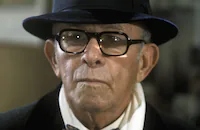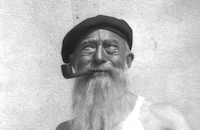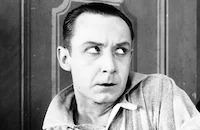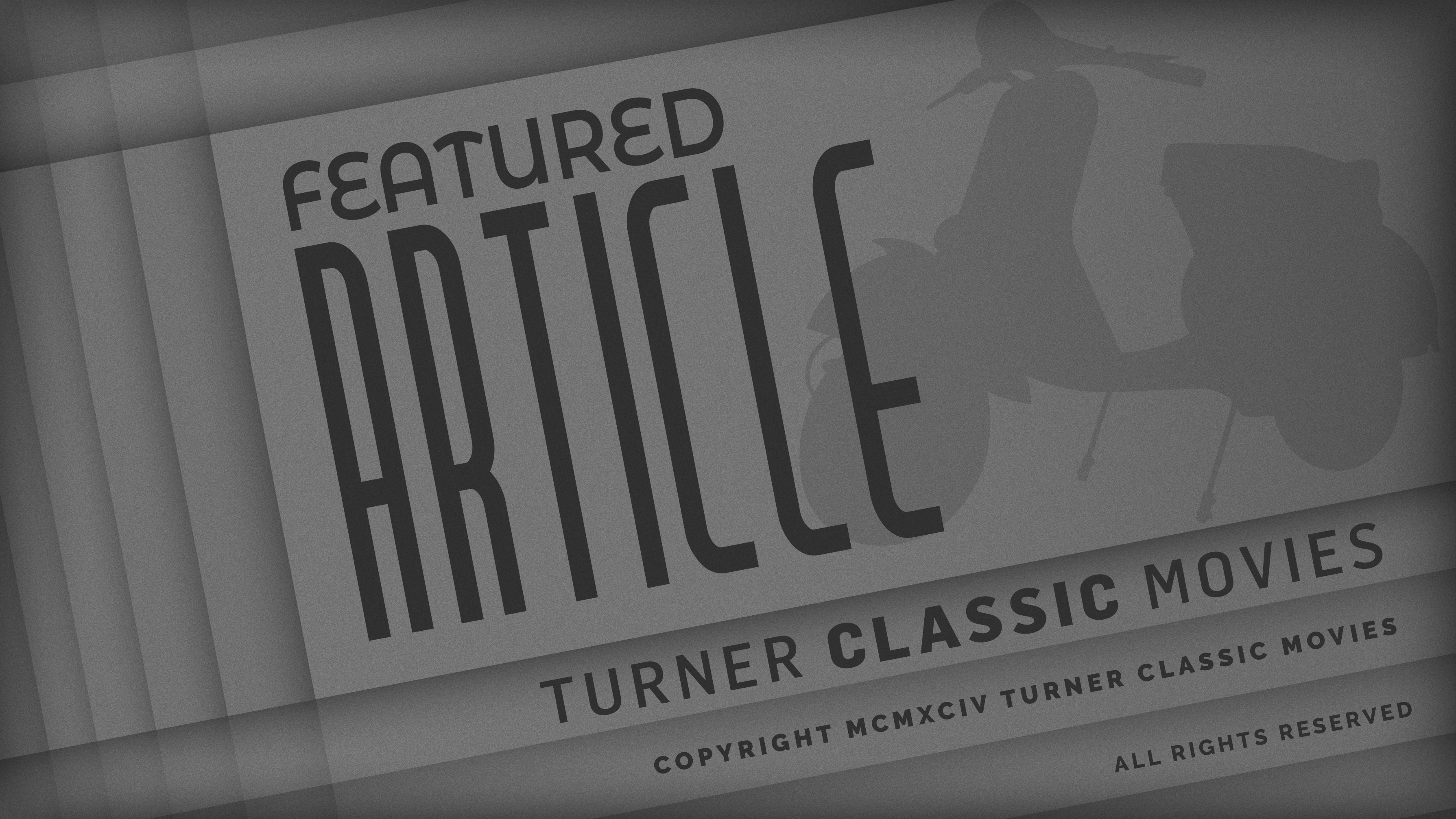International House
Brief Synopsis
Cast & Crew
Edward Sutherland
W. C. Fields
Stuart Erwin
Sari Maritza
George Burns
Gracie Allen
Film Details
Technical Specs

Synopsis
Dr. Wong, inventor of the radioscope, which can broadcast both picture and sound from anywhere in the world, holds a conference at the hotel International House in Wu-Hu, China. Before the conference, Tommy Nash of the American Electric Company was almost married, but contracted chicken pox and left his bride-to-be, Carol Fortescue, alone at the altar. As Carol arrives in Wu-Hu, Tommy is forced to spend the night in Shanghai, where he meets well-known beauty Peggy Hopkins Joyce. Representatives of companies all over the world arrive for Wong's presentation, but he delays it at Tommy's request, believing the American will present the highest bid. As Wong sets up his invention, the radioscope shows Professor Henry Quail ready to take off from Juarez, Mexico to Kansas City in his autogyro, the Spirit of Brooklyn , loading both his plane and his stomach with beer. When Tommy arrives with Peggy, Carol refuses to marry him, until Peggy explains that she and Tommy spent an innocent night together, and the couple is reconciled, only to have Tommy break out in a rash of measles. Meanwhile, Peggy's ex-husband, General Petronovich, to eliminate competition for Wong's patent, has the hotel quarantined for Tommy's rash but gets himself locked out. Still waiting for Tommy to introduce himself, Wong postpones his demonstration until Quail lands his autogyro on the roof and Wong, believing he is Tommy, offers his patent to him. That night, Quail sleeps in Peggy's room and the next morning, she asks him to fly away with her. Tommy then has the quarantine lifted, rushes to Wong and secures the patent. Petronovich then storms the hotel, threatening to kill whomever has won Wong's patent and is enraged to see Peggy in Quail's car, which he brought with him on the plane. Peggy runs to the roof to escape Petronovich just as Tommy and Carol, now in Quail's car in the elevator, save him from Petronovich. All reach the plane in time and the Spirit of Brooklyn takes off.

Director
Edward Sutherland
Cast

W. C. Fields

Stuart Erwin

Sari Maritza

George Burns

Gracie Allen

Bela Lugosi

Edmund Breese
Lumsden Hare

Franklin Pangborn
Harrison Greene

Rudy Vallee
Colonel Stoopnagle
Budd

Cab Calloway And His Orchestra

Sterling Holloway
Baby Rose Marie
Lona Andre
The Girls In Cellophane
Henry Sedley
James Wang
Ernest Wood
Edwin Stanley
Clem Beauchamp
Norman Ainsley
Louis Vincenot
Bo-ling
Etta Lee
Bo-ching
Crew
Guy Bennett
Neil Brant
Walter Deleon
Farciot Edouart
Eli Fredericks
Loyal Griggs
Ernest Haller
Louis E. Heifetz
Francis Martin
Thomas Morris
Al Myers
Guy Newhardt
Ralph Rainger
Andy Razaf
Leo Robin
J. Russel Robinson
Dewey Wrigley

Film Details
Technical Specs

Articles
International House
When the movies learned to talk, Fields was not one of the first comedians the studios sought for their sound films. It was rather surprising considering his impeccable physical timing combined with his comedic asides during his amazing juggling displays. Fields' snide commentary delivered via that marvelous nasal voice was a natural for the 'talkies.' Finally, RKO filmed his legendary golf act as a short, The Golf Specialist (1930), followed by his sound feature debut in Warners' Her Majesty, Love (1931). Paramount got the message, and recalled their renowned alumnus to appear in the wonderful If I Had a Million and the wildly wacky Million Dollar Legs (both 1932), a package of popular all-star extravaganzas. Still searching for that perfect solo Fields vehicle, the studio continued to put him in as a sure fire laugh getter in omnibus-type musical comedies. So after appearing for producer Mack Sennett, now ensconced at Paramount, in a brilliant quartet of two-reelers (The Dentist (1932), The Barber Shop, The Pharmacist, The Fatal Glass of Beer, all 1933), Fields was once again scripted in as a specialty attraction for the upcoming International House (1933), a lavish all-star romp complete with songs, comedy skits, and specialty numbers.
For Fields, it was like old home week, as his director was longtime friend and drinking buddy, A. Edward Sutherland. British-born Sutherland, no stranger to show business or comedy, was the son of theatrical producer Al Sutherland and vaudeville superstar Julie Ring. Indeed, famous relatives peppered his extensive family tree on both sides of the footlights, including playwright J.H. Ring, uncle Thomas Meighan (a major silent star) and aunt Charlotte Greenwood. Briefly married to Louise Brooks (leading lady of his 1926 Fields silent, It's the Old Army Game), Sutherland sailed into the slapstick arena shortly after arriving in America, becoming one of the Keystone players at the age of 19. Yearning to direct, Sutherland spent the next few years honing his craft, landing the plum job of Chaplin's assistant on A Woman of Paris (1923). Aside from Fields, Sutherland would smoothly navigate a number of comedians through their paces, including Wallace Beery, Raymond Hatton, the underrated Raymond Griffith, Eddie Cantor, Mae West, Laurel & Hardy, and Abbott & Costello.
As entertaining today as it was at the time of its release, International House fascinates because of its diverse cast, running the gamut from Burns & Allen to a suave Bela Lugosi as a jealous Russian, and a unique framing device (a Chinese inventor calling world reps to bid on his invention: a television set that can zero in on any on-going event - in actuality, a precursor to Direct TV!). It is Fields, however, who steals the show, from the time he lands his rickety bi-plane, The Spirit of Brooklyn, atop the roof of the title residence. Spouting a series of eyebrow-raising one-liners that a year later would be impossible (due to the revised 1934 Production Code), Fields' side-splitting precision easily demonstrates why he was one of the greatest comics of all time!
Much of the "blue" content can be contributed to the movie's nominal lead, Peggy Hopkins Joyce, a fun loving playgirl, who briefly captured the public's fancy. Playing herself, she is the butt (no pun) of an array of ribald gags from both Fields and Stuart Erwin. Her presence alone may have prompted the lax inclusion of a Baby Rose Marie torch song (which made many reviewers uncomfortable) and the fabulous Cab Calloway "Reefer Man" number. The edgy adult content did not evade the critics; the Motion Picture Herald commented that the "...Action and dialogue are fast and furious. But much of the double-meaning dialogue is of the ultra-risque type that is apt to start the censors on the warpath." while The Nation admitted that Paramount stood a good chance "...of making the picture a popular successor to 42nd Street."
Director: A. Edward Sutherland
Screenplay: Neil Brant (story), Walter DeLeon, Louis E. Heifetz (story), Francis Martin
Cinematography: Ernest Haller
Costume Design: Travis Banton
Original Music: Howard Jackson (uncredited), John Leipold (uncredited), Ralph Rainger, Leo Robin
Cast: Peggy Hopkins Joyce (Herself), W.C. Fields (Prof. Henry R. Quail), Stuart Erwin (Tommy Nash), Sari Maritza (Carol Fortescue), George Burns (Doctor Burns), Bela Lugosi (General Petronovich), Gracie Allen (Nurse Allen), Edmund Breese (Doctor Wong), Franklin Pangborn (Hotel Manager).
BW-70m.
by Mel Neuhaus

International House
Quotes
No, the doctor isn't in just now. Oh, he won't be back for a long, long time. He went out on one of those eternity cases.- Nurse Allen
Won't you join me in a glass of wine?- Peggy
You get in first, and if there's room enough I'll join you.- Professor Quail
I wonder what their parents were.- Peggy
Careless, my little dove cake, careless.- Professor Quail
Are you going to marry a millionaire ?- Tommy Nash
I never marry anything else.- Peggy
Hey! Where am I?- Professor Quail
Wu-Hu.- Woman
Woo-Hoo to you sweetheart. Hey Charlie, where am I?- Professor Quail
WU-HU!- Hotel Manager
Don't let the posy fool you!- Professor Quail
Trivia
The characters viewed on Dr. Wong's radioscope were popular radio stars of the time.
A mild earthquake struck during the filming of one of W.C. Fields' scenes, and was captured on film. The few seconds of film taken after the cameraman abandoned the scene show Fields calmly ushering everyone off the soundstage and telling them to stay calm and walk slowly.
Notes
Excerpts from this film were shot at Eastern Service Studios, formerly Paramount's Astoria Studio. Rudy Valee, Cab Calloway and his orchestra, Baby Rose Marie and Colonel Stoopnagle and Budd all actually performed in this film as shown on Wong's radioscope. Manhattan socialite Peggy Hopkins Joyce, who appeared on Broadway in Earl Carroll's Vanities and the Ziegfeld Follies, was called, according to a modern source, "A Circe of the Cinema" when she arrived in Hollywood to star in the 1926 film Skyrocket. International House marked her return to the screen after seven years. According to files in the MPAA/PCA Collection at the AMPAS Library, on January 28, 1933, Dr. James Wingate, Director of the Studio Relations Office of the AMPP, wrote to Paramount executive Harold Hurley stating that this film was "satisfactory under the [Production] Code, providing the [scene] with Gracie Allen and the stethoscope is handled so as to avoid any possible offense under the Code against vulgarity." On February 18, 1933, Wingate wrote to Paramount producer A. M. Botsford advising "great care" in the filming of the stethoscope gag and the scene in which Professor Quail and Peggy Hopkins Joyce end up in the same bedroom by mistake, as well as the scene in which Peggy loses her skirt in the door of the Austin. Wingate further warned, "...this is a type of picture with which censor boards recently have been dealing severely, with particular reference to double-meaning lines and gags..."
On May 8, 1933, after the Hays Office viewed the film, Wingate sent Botsford an official list of recommended deletions, which include: 1. Gracie seated on stethoscope in which she says she can hear her heart beat. 2. Fields' line, "Don't let a flower deceive you," "as an inference of sex perversion." 3. the dance girls bent over and the camera "focused on their posteriors." 4. Fields' peering into a keyhold and saying, "What won't they be trying next." 5. Fields' line, "What isn't crosswise in China." 6. Fields' line, "Careless," in reference to the parents of a litter of cats. [The line, which closes the film, read-PEGGY: "I wonder what their parents were?" FIELDS: "Careless, my little nut cake, careless."] On May 10, 1933, Botsford wrote to Wingate with the following protest: "1. We are very much perturbed by the suggested deletions which we feel eliminate considerably comedy, and comedy which is, we believe, entirely innocuous. The stethoscope gag by Gracie Allen has no element of offense of it. Gracie Allen is a dumb girl who makes all kinds of mistakes constantly and the very way the scene is played cannot, we believe, cause offense to the most squeamish person in the audience. It is merely funny. 2. Fields' line "Don't let the flower deceive you" indicates merely a "sissy" reaction. It would take an expert in abnormal psychology to wheedle out of that an inference of sex perversion. 3. The shot in the dance routine in question might be argued about, although there have been dance routines with exposures of this sort in films constantly. I know we are not supposed to hark back to what other people have done, however. 4. Fields' line into the keyhole, "What won't they think of next," is smutty only in the minds of persons who want to construct smut out of it. 5. The "crosswise in China" line will come out. 6. The "careless" line in reference to the parents of the cats is, we believe, merely innocuous in this day and age. Such references are constantly made in public and in print, and are not indicative of anything particularly obnoxious." The "crosswise" line was cut May 12, 1933, making the film satisfactory under the Code.
On June 23, 1933, however, Hays Office representative James B. M. Fisher sent a memo to Wingate protesting the scene in which Peggy sits on a cat in Fields' Austin automobile. Fisher states: "It seems apparent from what a number of people have said to me that the studio "pulled a fast one" by changing the scene between W. C. Fields and Peggy Joyce in the Austin when Peggy keeps repeating, "I'm sitting on something" and Fields pays no attention, but eventually reaches down and produces a cat....In the version which we saw, it is my recollection that the scene went as follows: A shot of the car with a door open establishes unmistakably the presence of a cat lying on the seat. Peggy and Fields climb into the car and drive off, and then Peggy starts to wiggle around repeating, "I'm sitting on something." [Fields pulls out a flattened cat and says, "It's a cat."] "...and it is my impression that he used the word, "cat," rather than "pussy." ...From various comments, it appears we are taking a terrific beating in allowing something to pass which is unmistakably vulgar." Maryland censor boards eliminated Peggy's line, "I tell you I am sitting on something" and Fields answer, "It's a pussy," which Pennsylvania censors also eliminated. In the viewed print, the audience does not see the cat until after Fields has stopped the car to remove it, uttering "It's a pussy."
These deletions caused Carl E. Milliken, Secretary of the MPPDA, to write to Joseph I. Breen, also of the Hays Office, following a conversation he had with Ed Kuykendall, president of the Motion Picture Theatre Owners of America. Milliken writes, "Among other things [Kuykendall] suggested that some time he ought to have an opportunity to tell the executives actually responsible for production in Hollywood what the average decent minded exhibitor thinks of some of their product and why." Milliken mentions the censored "pussy" line and went on to say, "...the whole picture is vulgar and borders constantly on the salacious according to the comments of the public groups. Originally our west coast office required six deletions under the Code. The studio gave them an argument on all of them and they finally insisted upon only one [presumably the "pussy" line] ...This deletion was not made, as evidenced by the report of the reviewer who saw the print in New York....the dirty minded lout who put it in the picture knew perfectly well, however, what he was doing and undoubtedly felt he had gained something by getting away with it. I wish that Kuykendall or somebody whose words would carry weight could manage to give him an impression of the opinion that is rapidly developing throughout this country regarding him and his kind." The last two reels of the film were reviewed by the Hays Office on June 26, 1933. The film was released with the line in question intact in 1933, but when Paramount requested a Code seal for a re-issue for the film in October 1935, the PCA suggested that Paramount withdraw its application. Breen wrote to Paramount executive John Hammell that the film "is filled with gross vulgarities in both action and dialogue." When Paramount again tried to re-issue the film in March 1950, Breen re-iterated for Paramount executive Luigi Luraschi the list of deletions recommended in 1933, as well as the song "Reefer Man," sung by Cab Calloway.
According to a modern source, The Spirit of Brooklyn car, W. C. Fields' own baby Austin, was also used in the Ziegfeld Follies of 1925 and later in Earl Carroll's Vanities. The Variety review called this film "just dull hoke," but, according to modern sources, it finally secured Fields' place in Hollywood. Following the success of International House, Paramount guaranteed Fields $100,000 a year and three pictures-a-year for three years; compared with the mere $15,000 he received for this film. According to Hollywood Reporter, Peggy Hopkins Joyce was guaranteed $1,250 per week and a four-week guarantee for appearing in this film.
During the film's production, the 1933 Long Beach earthquake occurred. A now famous film clip taken on the set of the picture features Stuart Erwin saying "It's an earthquake," and a composed Fields calmly directing everyone to take it easy. Although the clip was purportedly taken during the actual quake, while a scene was being shot, director Edward Sutherland revealed in a modern interview what many film historians had suspected, that the footage was actually shot later, as a joke. Colonel Lemuel Q. Stoopnagle (actually Frederick Chase Taylor) and Budd Hulick were a popular radio team from 1933-1938. They were first heard on network radio on May 25, 1931 in a three-a-week, fifteen-minute trial run format called Gloom Chasers, on CBS. Modern sources credit Jerry Drew and André Cheron as bit players.














